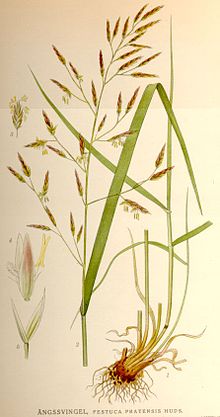
Lolium is a genus of tufted grasses in the bluegrass subfamily (Pooideae). It is often called ryegrass, but this term is sometimes used to refer to grasses in other genera.

Festuca (fescue) is a genus of flowering plants belonging to the grass family Poaceae. They are evergreen or herbaceous perennial tufted grasses with a height range of 10–200 cm (4–79 in) and a cosmopolitan distribution, occurring on every continent except Antarctica. The genus is closely related to ryegrass (Lolium), and recent evidence from phylogenetic studies using DNA sequencing of plant mitochondrial DNA shows that the genus lacks monophyly. As a result, plant taxonomists have moved several species, including the forage grasses tall fescue and meadow fescue, from the genus Festuca into the genus Lolium, or alternatively into the segregate genus Schedonorus.

Festuca ovina, sheep's fescue or sheep fescue, is a species of grass. It is sometimes confused with hard fescue.
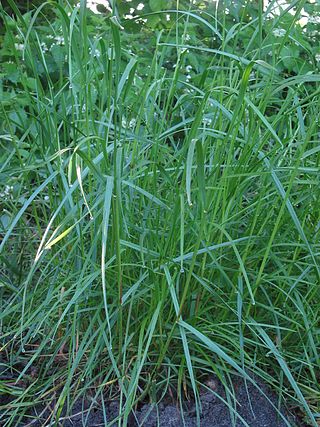
Lolium perenne, common name perennial ryegrass, English ryegrass, winter ryegrass, or ray grass, is a grass from the family Poaceae. It is native to Europe, Asia and northern Africa, but is widely cultivated and naturalised around the world.

Tragus, commonly called bur gras, burr grass or carrot-seed grass, is a genus of plants in the grass family. It is native to Africa, Australia, and Eurasia with several species on islands in the Atlantic, Indian, and Pacific Oceans plus one species in Argentina.
British NVC community MG6 is one of the mesotrophic grassland communities in the British National Vegetation Classification system. It is one of four such communities associated with well-drained permanent pastures and meadows.
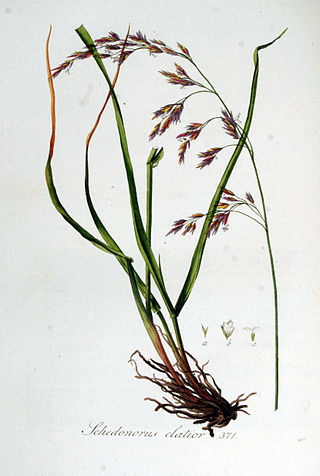
Festuca arundinacea (syn., Schedonorus arundinaceus and Lolium arundinaceum) is a species of grass commonly known as tall fescue. It is a cool-season perennial C3 species of bunchgrass native to Europe. It is an important forage grass throughout Europe, and many cultivars have been used in agriculture. It is also an ornamental grass in gardens, and a phytoremediation plant.

Festuca occidentalis is a species of grass known as western fescue. It is native to much of the northern half of North America and is most widely distributed in the west. It is most often found in forest and woodland habitat. The specific epithet occidentalis is Latin, meaning "western".

Bromus catharticus is a species of brome grass known by the common names rescuegrass, grazing brome, prairie grass, and Schrader's bromegrass. The specific epithet catharticus is Latin, meaning cathartic. The common name rescuegrass refers to the ability of the grass to provide forage after harsh droughts or severe winters. The grass has a diploid number of 42.

Festuca vivipara, the viviparous sheep's-fescue, is a species of grass native to northern Europe, northern Asia, and subarctic North America. The specific epithet vivipara is Latin, referring to the florets' alteration to leafy tufts. The plant can have a diploid number of 28, 49, 56, or 63, though numbers of 21, 35, and 42 have also been reported.
Hopia obtusa is a species of grass commonly known as vine mesquite. This plant was treated as Panicum obtusum until recently when more molecular and genetic material revealed new information about it. Hopia obtusa is now placed in the monotypic genus Hopia.

Festuca gigantea, giant fescue, is a plant species in the grass family, Poaceae.
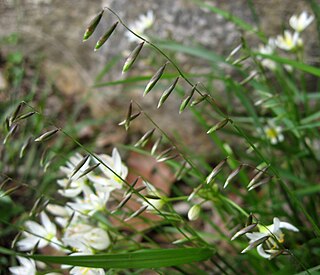
Melica mutica, the twoflower melicgrass, is a grass species in the family Poaceae that can be found in southeastern United States.
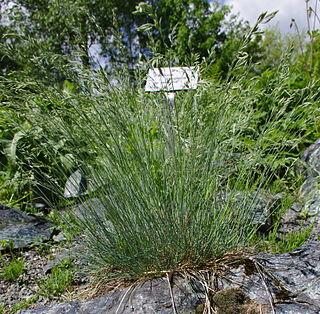
Festuca gautieri, commonly known as spiky fescue or bearskin fescue, is a species of flowering plant in the grass family, Poaceae, native to the Pyrenees. It is a commonly cultivated evergreen or semi-evergreen herbaceous perennial, and, as a native to European alpine areas, it is a small, low-growing Festuca suitable for rock gardens. It is first described in 1890.
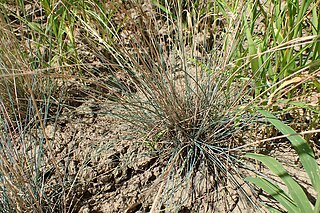
Festuca psammophila is a species of grass which is endemic to Central Europe.

Festuca brachyphylla, commonly known as alpine fescue or short-leaved fescue, is a grass native to Eurasia, North America, and the Arctic. The grass is used for erosion control and revegetation. The specific epithet brachyphylla means "short-leaved". The grass has a diploid number of 28, 42, or 44. This species was first described in 1827.
Bromus pacificus, the Pacific brome, is a perennial grass native to the Pacific coast of North America. Bromus pacificus has a diploid number of 28.

× Festulolium is a nothogenus of flowering plants in the grass family Poaceae. Naturally occurring hybrids, they are the result of crosses between species of two questionably distinct grass genera, Festuca and Lolium, and the hybrids show phenotypic similarities to both parents. This type of intergeneric hybridization is quite rare, and is indicated by a multiplication symbol before the name. The name Festulolium is an example of a portmanteau word, a combination of the two parents' names.
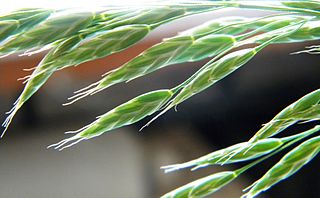
Bromus racemosus, the smooth brome or bald brome, is a species of flowering plant in the family Poaceae. It is native to subarctic and temperate Eurasia, and widely introduced elsewhere, including North America, Iceland, the Southern Cone of South America, the Korean Peninsula, Australia, and New Zealand. It grows in alkaline meadows and in waste places.
Festuca alpina, also known as the alphine fescue, is a species of grass in the genus Festuca. It grows in rocky habitats in many of the mountains chains across Europe. in the countries of Austria, Czechoslovakia, France, Germany, Italy, Spain, Switzerland and Yugoslavia.
